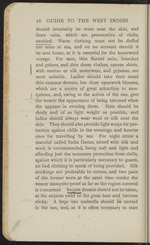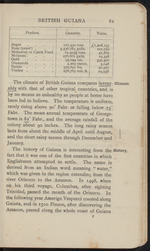| 1 |
 |
“...wraps for pro-
tection against chills in the evenings, and heavier
ones for travelling by sea. For night attire a
material called India Gauze, mixed with silk and
wool, is recommended, being soft and light and
affording just the necessary protection from chills,
against which it is particularly necessary to guard,
no bed clothing to speak of being provided. Silk
stockings are preferable to cotton, and two pairs
of the former worn at the same time render the
wearer mosquito proof as far as the region covered
is concerned. Sequin dresses should not be taken,
as the sequins yield to the great heat and become
sticky. A large sun umbrella should be carried
in the sun, and, as it is often necessary to start...”
|
|
| 2 |
 |
“...Fahr. or falling below <75°
Fahr. The mean annual temperature of George-
town is 82° Fahr., and the average rainfall of the
colony about 90 inches. The long rainy season
lasts from about the middle of April until August,
and the short rainy season through December and '
January.
The history of Guiana is interesting from the History,
fact that it was one of the first countries in which
Englishmen attempted to settle. The name is
derived from an Indian word meaning “ water ”
which was given to the region extending from the
river Orinoco to the Amazon. In 1498, when
on his third voyage, Columbus, after sighting
Trinidad, passed the mouth of the Orinoco. In
the following year Amerigo Vespucci coasted along
Guiana, and in 1500 Pinzon, after discovering the
Amazon, passed along the whole coast of Guiana
F...”
|
|
| 3 |
 |
“...i36,I47 142,965 132,973 £111,849 112,508 99,823 110,036 119,716 99,862
The amount of sugar exported in 1904-5 was
11,940 tons. Cotton to the value of ^£1358 was
also exported.
Climate. Antigua is subject to severe droughts, and the
average annual rainfall is as low as 46 inches.
The island has no rivers, and the wells or springs
in the central plain from St. John’s to Willoughby
Bay being brackish, the only water available is
that which is collected in ponds and pools. Wells
in the limestone region on the north-east of this
central plain yield good water, and there are a
few wells lying to the west and south of the plain.
The water supply of St. John’s is good, being
derived from the hills near Wallings, while Wall-
ings Reservoir furnishes a valuable subsidiary
supply for the country districts. In the winter
months the climate is healthy, except in the
neighbourhood of swamps and marshes. The
death rate is 30 per thousand, but this figure cannot...”
|
|
